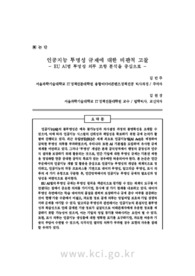

PARTNER
검증된 파트너 제휴사 자료
인공지능 투명성 규제에 대한 비판적 고찰 - EU AI법 투명성 의무 조항 분석을 중심으로 - (A Critical Review of Artificial Intelligence Transparency Regulation - Focusing on Transparency Obligations in the EU AI Act -)
50 페이지
최초등록일 2025.05.03
최종저작일
2025.04

-
미리보기
서지정보
· 발행기관 : 법무부
· 수록지 정보 : 선진상사법률연구 / 110호 / 59 ~ 108페이지
· 저자명 : 김민주, 김현경
초록
인공지능(AI)의 불투명성은 예측 불가능성과 의사결정 과정의 불명확성을 초래할 수 있으며, 이에 따라 인공지능 시스템의 신뢰성과 책임성을 확보하기 위한 규제 논의가 활발히 진행되고 있다. 최근 유럽연합(EU)은 세계 최초로 인공지능법(AI Act)을 제정하여 강력한 투명성 의무를 부과하였으며, 우리나라 또한 AI 기본법을 도입하며 유사한 규제 체계를 마련하고 있다. 그러나 ‘투명성’ 개념은 본래 공적영역에서 행정의 공정성과 민주적 절차를 보장하기 위해 활용되는 것으로, 민간 기업에 대한 투명성 규제는 기본권 제한을 정당화할 만큼 중대한 공익적 목표가 있는 경우에만 허용되어야 한다. 본 논문은 민간부문에서의 인공지능 개발 및 활용을 중심으로 인공지능 투명성의 개념을 체계적으로 정리하고, 인공지능의 작동 프로세스를 기반으로 데이터 투명성, 알고리즘 투명성, 표시 의무의 세 가지 유형으로 구분한 후, 민간영역에서의 인공지능 투명성 규제의 필요성과 정당성을 비판적으로 분석한다.
EU AI법의 투명성 규제는 투명성 원칙을 객관적으로 평가할 수 있는 체계적 도구를 마련했다는 점에서 중요한 의의를 가지지만, 동시에 몇 가지 한계를 내포하고 있다. 데이터 투명성 측면에서는 학습 데이터의 품질을 완벽히 보장하거나 규제 준수 여부를 검증하는 것이 현행 기술 수준에서 어렵고, 과도한 정보 공개 의무는 영업비밀 보호와 기업 경쟁력 저하 문제를 야기할 수 있다. 알고리즘 투명성과 관련해서는 인공지능의 본질적인 불투명성과 복잡성으로 인해 공개된 기술 정보가 실질적으로 이해관계자에게 유용한 정보를 제공하지 못할 가능성이 있으며, 이는 기업의 영업 동기를 약화시키는 요인이 될 수 있다. 또한, 표시 의무는 인공지능 생성물에 대한 명확한 표기를 요구하지만, 과도한 비용과 기술적 부담이 수반될 수 있으며, 적극적인 필터링 의무가 부과될 경우 표현의 자유를 침해할 우려가 있다.
인공지능 기술은 여전히 발전 초기 단계에 있으며, 그 사회적 영향을 정확히 예측하기 어려운 특성이 있다. 따라서 법적 강제보다는 기업의 자율적 책임을 기반으로 한 투명성 확보 방안을 모색하는 것이 보다 현실적이고 효과적인 접근법이 될 것이다. 본 연구는 이러한 관점에서 EU AI법을 중심으로 인공지능 투명성 규제의 개념과 한계를 분석하며, 향후 규제 설계에 있어 보다 신중한 접근이 필요함을 강조한다.영어초록
The lack of transparency in artificial intelligence(AI) can lead to unpredictability and opacity in decision-making processes, raising concerns regarding the reliability and accountability of AI systems.. As a response, regulatory discussions aimed at ensuring AI transparency have been gaining momentum. Recently, the European Union(EU) became the first in the world to enact the Artificial Intelligence Act(AI Act), imposing stringent transparency obligations. Similarly, South Korea has introduced the AI Framework Act, establishing a comparable regulatory framework. However, the concept of ‘transparency’ has inherently been employed in the public sector to ensure administrative fairness and democratic procedures. Therefore, transparency regulations on private enterprises should only be justified when an overriding public interest necessitates such a restriction on fundamental rights. This paper systematically examines the concept of AI transparency in the private sector, categorizing it into three types—data transparency, algorithmic transparency, and disclosure obligations—based on AI operational processes. Furthermore, it critically analyzes the necessity and justification of AI transparency regulations in the private sector.
The EU AI Act’s transparency provisions are significant in that they establish a systematic framework for objectively assessing transparency principles. However, several limitations remain. In terms of data transparency, ensuring the quality of training data or verifying regulatory compliance remains technically challenging. Excessive disclosure obligations may also pose risks to trade secrets and corporate competitiveness. Regarding algorithmic transparency, the intrinsic opacity and complexity of AI systems may prevent disclosed technical information from providing meaningful insights to stakeholders, potentially undermining corporate incentives for innovation. Additionally, disclosure obligations require clear labeling of AI-generated content, but their implementation may impose substantial costs and technical burdens. Furthermore, imposing stringent content-filtering requirements on AI service providers could raise concerns about potential infringements on freedom of expression.
Given that AI technology is still in its early stages of development and that its long-term societal impacts remain uncertain, a more pragmatic and effective approach would be to encourage voluntary accountability mechanisms rather than imposing rigid legal mandates. From this perspective, this study analyzes the concept and limitations of AI transparency regulations, focusing on the EU AI Act, and underscores the need for a more cautious approach in future regulatory design.참고자료
· 없음태그
-
자주묻는질문의 답변을 확인해 주세요

꼭 알아주세요
-
자료의 정보 및 내용의 진실성에 대하여 해피캠퍼스는 보증하지 않으며, 해당 정보 및 게시물 저작권과 기타 법적 책임은 자료 등록자에게 있습니다.
자료 및 게시물 내용의 불법적 이용, 무단 전재∙배포는 금지되어 있습니다.
저작권침해, 명예훼손 등 분쟁 요소 발견 시 고객센터의 저작권침해 신고센터를 이용해 주시기 바랍니다. -
해피캠퍼스는 구매자와 판매자 모두가 만족하는 서비스가 되도록 노력하고 있으며, 아래의 4가지 자료환불 조건을 꼭 확인해주시기 바랍니다.
파일오류 중복자료 저작권 없음 설명과 실제 내용 불일치 파일의 다운로드가 제대로 되지 않거나 파일형식에 맞는 프로그램으로 정상 작동하지 않는 경우 다른 자료와 70% 이상 내용이 일치하는 경우 (중복임을 확인할 수 있는 근거 필요함) 인터넷의 다른 사이트, 연구기관, 학교, 서적 등의 자료를 도용한 경우 자료의 설명과 실제 자료의 내용이 일치하지 않는 경우
문서 초안을 생성해주는 EasyAI
